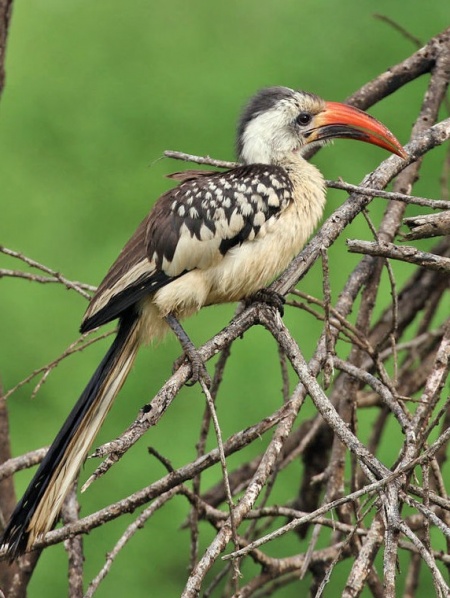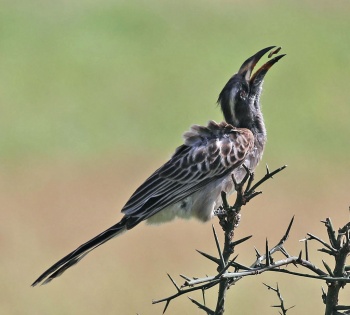m (→Identification) |
(Picture of juvenile) |
||
| (2 intermediate revisions by the same user not shown) | |||
| Line 1: | Line 1: | ||
| − | [[Image: | + | [[Image:TZP RedBilledHornbill MAN6751.jpg|thumb|450px|right|Photo © by {{user|mikemik|mikemik}}<br />Manyara, [[Tanzania]], May 2018]] |
;[[:Category:Tockus|Tockus]] erythrorhynchus | ;[[:Category:Tockus|Tockus]] erythrorhynchus | ||
==Identification== | ==Identification== | ||
| − | A small, black-and-white Hornbill. | + | 35 cm (13¾ in); A small, black-and-white Hornbill. |
| − | * Spotted wing-coverts | + | * Spotted wing-[[Topography#General Anatomy|coverts]] |
* Black tail with white in outer tail | * Black tail with white in outer tail | ||
| − | * Long, slender red bill with dark patch on lower mandible | + | * Long, slender red bill with dark patch on lower [[Dictionary_M-O#M|mandible]] |
* Yellow to pinkish bare skin around eye and on throat | * Yellow to pinkish bare skin around eye and on throat | ||
* Brown eyes | * Brown eyes | ||
| Line 12: | Line 12: | ||
==Distribution== | ==Distribution== | ||
| + | [[Image:TZP RedBilledHornbillJ SER61641.jpg|thumb|350px|right|Juvenile<br />Photo © by {{user|mikemik|mikemik}}<br />[[Serengeti National Park]], [[Tanzania]], May 2018]] | ||
From [[Sierra Leone]] east to [[Somalia]] and south to [[Tanzania]]. | From [[Sierra Leone]] east to [[Somalia]] and south to [[Tanzania]]. | ||
==Taxonomy== | ==Taxonomy== | ||
| − | This is a [[Dictionary_M- | + | This is a [[Dictionary_M-O#M|monotypic]] species.<br /> |
Was formerly considered included in [[Red-billed Hornbill]]. | Was formerly considered included in [[Red-billed Hornbill]]. | ||
| + | |||
==Habitat== | ==Habitat== | ||
Tree and bush savanna. | Tree and bush savanna. | ||
==Behaviour== | ==Behaviour== | ||
| + | ====Diet==== | ||
Feeds mainly on insects but takes also small vertebrates like geckos, nestlings and rodents. Some fruits and grain eaten, too.<br /> | Feeds mainly on insects but takes also small vertebrates like geckos, nestlings and rodents. Some fruits and grain eaten, too.<br /> | ||
| − | Feeds mainly on the ground. | + | Feeds mainly on the ground. |
| − | Breeding season from March to November. Nest in a natural cavity or in an old barbet or woodpecker hole. The female seals the entrance with | + | ====Breeding==== |
| − | Often takes over nest of other hornbill species. | + | Breeding season from March to November. Nest in a natural cavity or in an old barbet or woodpecker hole. The female seals the entrance with her own droppings and food remains. There is one narrow entrance through which the male passes food to the mother and chicks. Lays 2 - 7 eggs.<br /> |
| + | Often takes over nest of other hornbill species. | ||
| + | ====Movements==== | ||
Undertakes food-related local movements. | Undertakes food-related local movements. | ||
==References== | ==References== | ||
| − | #{{Ref-HBWVol6}}#{{Ref- | + | #{{Ref-HBWVol6}}#{{Ref-Clements6thAug18}} |
{{ref}} | {{ref}} | ||
==External Links== | ==External Links== | ||
{{GSearch|Tockus+erythrorhynchus}} | {{GSearch|Tockus+erythrorhynchus}} | ||
[[Category:Birds]] [[Category:Tockus]] | [[Category:Birds]] [[Category:Tockus]] | ||
Revision as of 20:18, 12 November 2018
- Tockus erythrorhynchus
Identification
35 cm (13¾ in); A small, black-and-white Hornbill.
- Spotted wing-coverts
- Black tail with white in outer tail
- Long, slender red bill with dark patch on lower mandible
- Yellow to pinkish bare skin around eye and on throat
- Brown eyes
Females are smaller and have only a small dark patch on the lower mandible.
Juveniles are similar to males but have a shorter and pale orange bill.
Distribution
From Sierra Leone east to Somalia and south to Tanzania.
Taxonomy
This is a monotypic species.
Was formerly considered included in Red-billed Hornbill.
Habitat
Tree and bush savanna.
Behaviour
Diet
Feeds mainly on insects but takes also small vertebrates like geckos, nestlings and rodents. Some fruits and grain eaten, too.
Feeds mainly on the ground.
Breeding
Breeding season from March to November. Nest in a natural cavity or in an old barbet or woodpecker hole. The female seals the entrance with her own droppings and food remains. There is one narrow entrance through which the male passes food to the mother and chicks. Lays 2 - 7 eggs.
Often takes over nest of other hornbill species.
Movements
Undertakes food-related local movements.
References
- Del Hoyo, J, A Elliot, and J Sargatal, eds. 2001. Handbook of the Birds of the World. Volume 6: Mousebirds to Hornbills. Barcelona: Lynx Edicions. ISBN 978-8487334306
- Clements, J. F., T. S. Schulenberg, M. J. Iliff, D. Roberson, T. A. Fredericks, B. L. Sullivan, and C. L. Wood. 2018. The eBird/Clements checklist of birds of the world: v2018. Downloaded from http://www.birds.cornell.edu/clementschecklist/download/
Recommended Citation
- BirdForum Opus contributors. (2024) Northern Red-billed Hornbill. In: BirdForum, the forum for wild birds and birding. Retrieved 19 April 2024 from https://www.birdforum.net/opus/Northern_Red-billed_Hornbill





